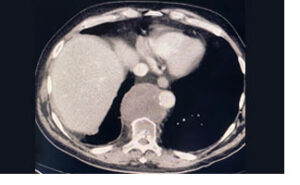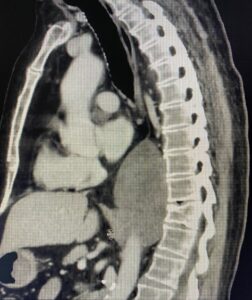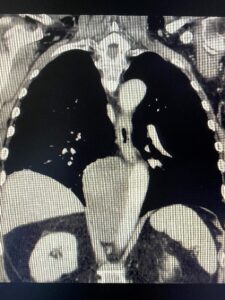
In the summer of 2019, Paul Pezzote, 67, learned he had Stage 4 cancer. Pezzote, who has Parkinson’s disease, had undergone treatments in 2010 at Dana-Farber/Brigham and Women’s Cancer Center (DF/BWCC). However, the cancer had returned and spread.
At DF/BWCC, Pezzote’s medical oncologist, Christopher Sweeney, MBBS, contacted Scott James Swanson, MD, Director, Minimally Invasive Thoracic Surgery, Brigham and Women’s Hospital and Associate Chief of Surgery, Dana-Farber/Brigham and Women’s Cancer Center, to discuss whether the tumor, which involved a large portion of Pezzote’s chest and abdomen, could be removed.
Dr. Swanson performed a biopsy using a cutting-edge and minimally invasive technique known as video-assisted thoracic surgery (VATS). The biopsy confirmed that a metastatic yolk sac tumor (YST) the size of a grapefruit was wrapped around his aorta and had invaded his spine.
“The tumor wasn’t removable, not in a traditional way,” said Dr. Swanson. “I told Dr. Sweeney that I might never be able to remove the tumor, but we could try shrinking it with chemotherapy so perhaps we could remove it later.”
New Chief of Cardiac Surgery Expands Possibilities
By May of 2020, chemotherapy had shrunk Pezzote’s tumor somewhat. That month, Thomas Gleason, MD, a thoracic-aortic surgeon joined the Brigham as chief of the Division of Cardiac Surgery and co-executive director of the Heart & Vascular Center.
A week into Dr. Gleason’s new role at the Brigham, Dr. Swanson asked him to consult on Pezzote’s case. With expertise in treating aortic disease and a history of pioneering innovative operations on the aorta, Dr. Gleason reviewed the patient’s images. He consulted with colleagues at the Brigham and beyond to determine whether the operation could be accomplished.

“To my knowledge, a surgical replacement of the thoracoabdominal aorta for an invasive cancer like Mr. Pezzote’s hasn’t been described,” said Dr. Gleason. “But Dr. Swanson and I discussed the feasibility of removing the aorta along with the tumor—via an en bloc resection—as we couldn’t remove the tumor in its entirety given its involvement with the aorta. After careful consideration and extensive discussion with Mr. Pezzote, we proceeded with the surgery.”
The operation, which would replace the distal thoracic and abdominal aorta, carried risks. These included the possibility of paralysis or even death. It was also difficult to know how an older adult with Parkinson’s disease would tolerate such a major procedure.
“Dr. Gleason and I had the combined expertise to make this operation possible,” said Dr. Swanson. “But given that it had never been done before, it was still like flying to the moon.”
Removing the Tumor Surrounding the Aorta
By July of 2020, Pezzote’s tumor had shrunk a bit more but it was still wrapped around the aorta and embedded in the back of his chest and upper abdomen. Since the tumor involved the spine, Michael W. Groff, MD, a spine surgeon, joined Dr. Gleason and Dr. Swanson during the operation to remove the tumor from the spinal column.
The procedure began on a Friday morning. To expose Pezzote’s heart, Dr. Gleason made a large thoracoabdominal incision. He then removed Pezzote’s aorta along with the growth and maintained circulation to his body using a cardiopulmonary bypass machine.

“Before we saw the tumor, we didn’t know if we could get it out,” said Dr. Swanson. “Fortunately, the tumor had receded from the spine, so Dr. Groff didn’t have to operate on the spinal column. There were many steps where we could’ve had complications, but every phase succeeded due to thorough planning and execution.”
With the aorta removed, Dr. Swanson and Dr. Gleason lifted the tumor out of Pezzote’s chest and abdomen.
“There are only a handful of surgeons in the world who could have done this operation,” said Dr. Swanson. “It requires several characteristics in one person. First, Dr. Gleason has incredible technical expertise. Second, he has experience with this type of operation, so he recognizes every precise step. Third, he has a rare vision and ability to anticipate problems before they happen. Lastly, he has the confidence to do it.”
Hours later, Pezzote awoke with no complications. He remained on bedrest for a few days and walked on his own a few days after. After recovering from the operation, Pezzote spent three weeks at the SpauldingTM Rehabilitation Network, mainly to help ease Parkinson’s symptoms.
Unique Partnership Between Thoracic and Cardiac Surgery
“There’s not often a lot of cross-talk between thoracic surgery and cardiac surgery,” said Dr. Gleason. “In my experience, most thoracic oncologists would consider a malignancy involving the aorta incurable. It took this unique partnership between our two departments to think outside the box. Without it, the patient would have died from his cancer.”
Drs. Gleason and Swanson agree this kind of collaboration between the Division of Thoracic Surgery and the Division of Cardiac Surgery will expand the possibilities of treating advanced cancer at the Brigham. Pioneering surgeries like the one they performed on Pezzote will also inspire the next generation of thoracic and cardiac surgeons.
“As we continue to push the boundaries of treating advanced cancer, we shouldn’t become too aggressive or disregard the biology of cancer,” said Dr. Swanson. “We should only operate advanced disease if we’re do so safely, achieving favorable surgical outcomes and our patients’ quality of life is improving.”
Pushing the Boundaries of Treating Advanced Cancer
At present, Pezzote has no signs of cancer and is doing well at home. Since the operation, Dr. Swanson and Dr. Gleason have performed more complicated thoracic-cardiac cases and plan to carry out many more.
“These types of surgeries help change the world of cancer,” said Dr. Swanson. “Dana-Farber/Brigham and Women’s Cancer Center leads the world in new cancer therapies, and the Brigham has expert surgeons who can pioneer treatments in thoughtful, innovative ways.”
“Chances are low that Mr. Pezzote would’ve received treatment anywhere else in the world right now,” said Dr. Gleason. “If referring doctors have a difficult case, the Brigham will go to great lengths to resolve it. We will offer every case a level of innovation and intense thought.”